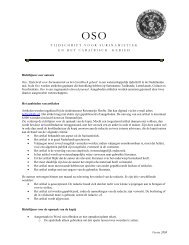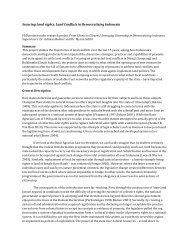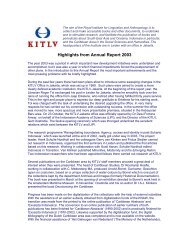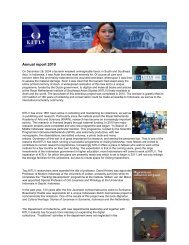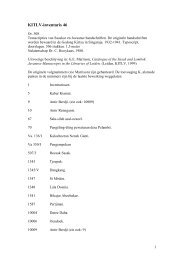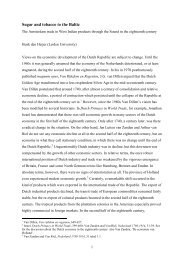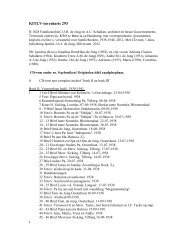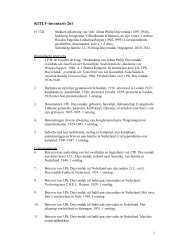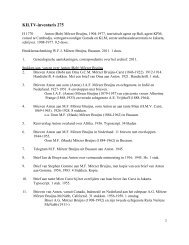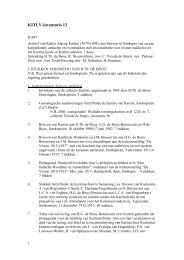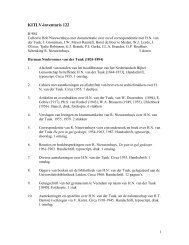The Acehnese past and its present state of study R. Michael ... - kitlv
The Acehnese past and its present state of study R. Michael ... - kitlv
The Acehnese past and its present state of study R. Michael ... - kitlv
You also want an ePaper? Increase the reach of your titles
YUMPU automatically turns print PDFs into web optimized ePapers that Google loves.
<strong>The</strong> <strong>Acehnese</strong> <strong>past</strong> <strong>and</strong> <strong>its</strong> <strong>present</strong> <strong>state</strong> <strong>of</strong> <strong>study</strong> 11<br />
<strong>The</strong> next major court scholar <strong>of</strong> Islam prominently appearing in texts<br />
known to us today was ‘Abd al-Ra’uf al-Singkili (d. 1693), a locally born<br />
scholar who had returned to Aceh after two decades <strong>of</strong> <strong>study</strong> in Arabia. His<br />
learning is refl ected in a number <strong>of</strong> works in the Islamic religious sciences,<br />
most <strong>of</strong> which were produced under the patronage <strong>of</strong> the <strong>Acehnese</strong> court<br />
after his return from his studies in the Middle East. Notable among these<br />
compositions is the Mir’at al-tullab, in which he advanced a Shari‘a-based<br />
argument for the legitimacy <strong>of</strong> a female to serve as the head <strong>of</strong> a Muslim <strong>state</strong><br />
(khalifa) (Amirul Hadi 2004:60). For ‘Abd al-Ra’uf, this was not an abstract,<br />
hypothetical ruling, but rather a concrete reference to the situation in Aceh<br />
during his day, as the sultanate was ruled by a succession <strong>of</strong> four sultanas<br />
between 1641 <strong>and</strong> 1699.<br />
As rich as this particular body <strong>of</strong> texts is, it must be noted that there is<br />
more to seventeenth-century Aceh than internal Sufi polemic, <strong>and</strong> Islam,<br />
although undeniably important, is not in <strong>its</strong>elf suffi cient to explain the history<br />
<strong>of</strong> <strong>Acehnese</strong> culture <strong>and</strong> society over the centuries. <strong>The</strong>re were also complex<br />
political <strong>and</strong> economic developments in the <strong>Acehnese</strong> sultanate that cannot<br />
be explained as simply refl ections <strong>of</strong> <strong>its</strong> Islamic identity. One example <strong>of</strong><br />
such developments is evocatively depicted in Sher Banu Khan’s contribution<br />
to this volume. In her narration <strong>and</strong> interpretation <strong>of</strong> ‘the jewel affair’, she<br />
demonstrates some <strong>of</strong> the ways in which Sultana Safi yyat al-Din Taj al-<br />
‘Alam Syah (r. 1641-1675) negotiated her assertion <strong>of</strong> new priorities in the<br />
allocation <strong>of</strong> royal resources, as well as the manner in which <strong>of</strong>fi cials <strong>of</strong> the<br />
Vereenigde Oost-Indische Compagnie (VOC, Dutch East India Company)<br />
reacted to the ascendancy <strong>of</strong> a female ruler in the <strong>Acehnese</strong> sultanate during<br />
the late seventeenth century. This <strong>study</strong> provides a richly detailed view into<br />
the diplomatic tensions that arose in the period <strong>of</strong> transition to the rule <strong>of</strong> the<br />
four sultanas in the seventeenth century, as well as complex aspects <strong>of</strong> Aceh’s<br />
relations with emerging European powers in the early modern period.<br />
<strong>The</strong> interventions <strong>of</strong> the VOC at that time eventually resulted in the<br />
realignment <strong>of</strong> trade relationships that hastened Aceh’s decline as both a port<br />
<strong>and</strong> a polity in the mid-seventeenth century (Ito 1984:451). With the abdication<br />
<strong>of</strong> the last sultana (Keumalat Syah, r. 1688-1699), power passed into the h<strong>and</strong>s<br />
<strong>of</strong> prominent Arab migrants who had established themselves in Aceh during<br />
the seventeenth century. 14 This transition was a notably rough one, with a<br />
rapid succession <strong>of</strong> three sultans in the fi rst four years. Relative stability was<br />
only achieved with the ascension <strong>of</strong> Jamal al-‘Alam Badr al-Munir (Poteu<br />
14 During the early eighteenth century, other Hadrami creole migrants also established themselves<br />
at Siak, Mempawa, Matan, Kubu <strong>and</strong> Pontianak. At the same time, integration <strong>of</strong> both<br />
Bugis <strong>and</strong> Arab elements elsewhere took place, with the establishment <strong>of</strong> the ‘Four Youths <strong>of</strong><br />
Tarim’, who pioneered the expansion into various parts <strong>of</strong> Sumatra, Kalimantan <strong>and</strong> the Malay<br />
Peninsula (Engseng Ho 2002).




